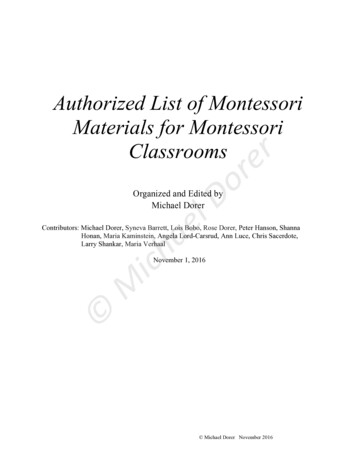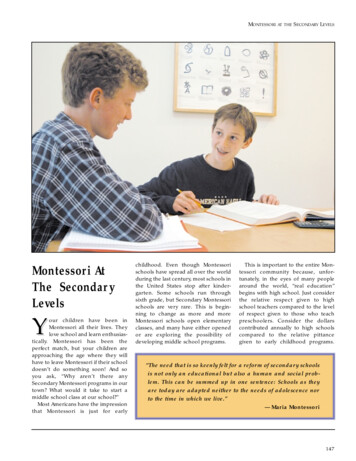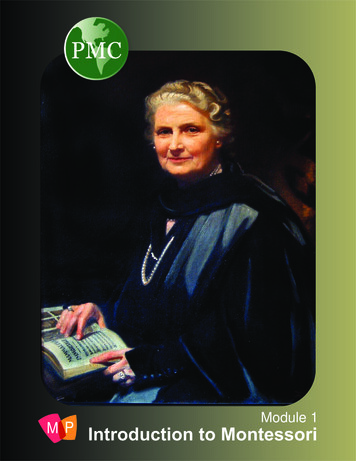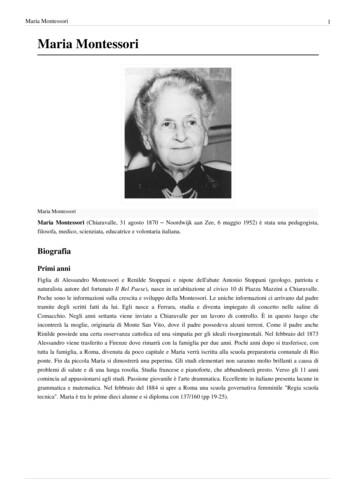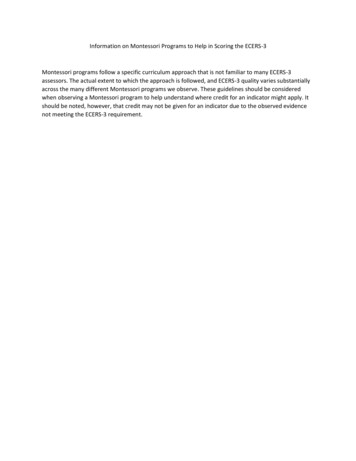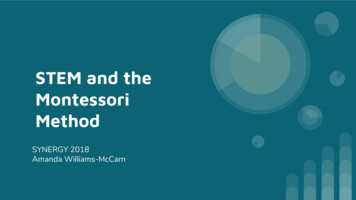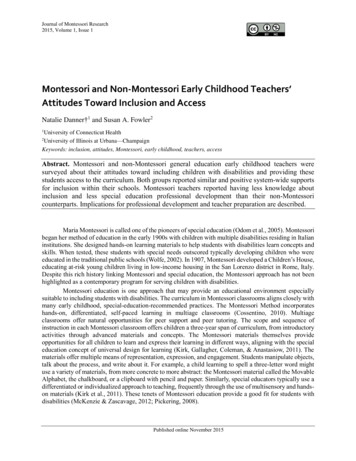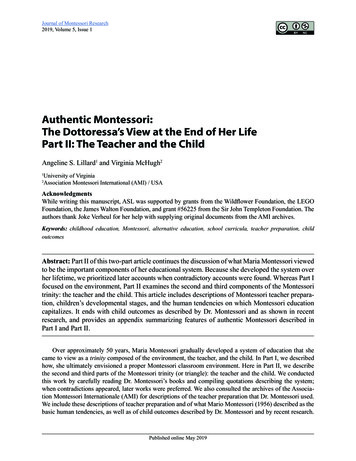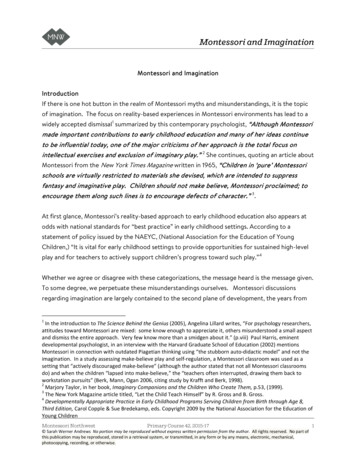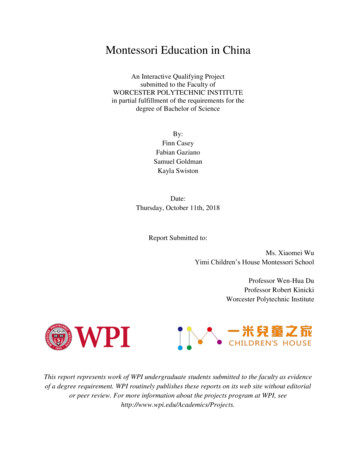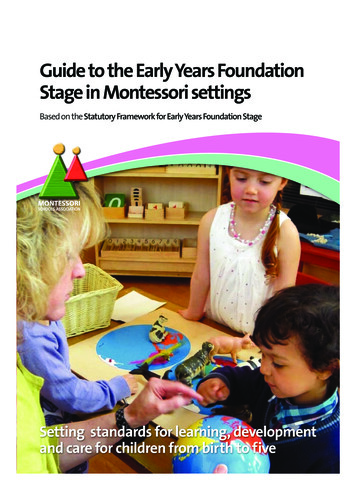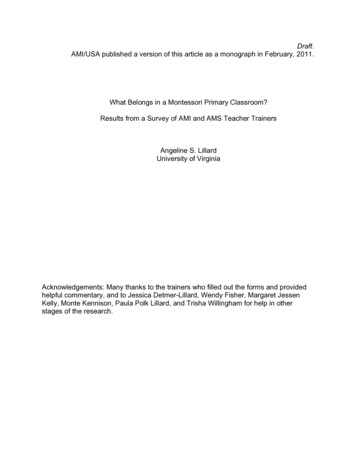
Transcription
Draft.AMI/USA published a version of this article as a monograph in February, 2011.What Belongs in a Montessori Primary Classroom?Results from a Survey of AMI and AMS Teacher TrainersAngeline S. LillardUniversity of VirginiaAcknowledgements: Many thanks to the trainers who filled out the forms and providedhelpful commentary, and to Jessica Detmer-Lillard, Wendy Fisher, Margaret JessenKelly, Monte Kennison, Paula Polk Lillard, and Trisha Willingham for help in otherstages of the research.
Materialsp. 2What Belongs in a Montessori Primary Classroom?Results from a Survey of AMI and AMS Teacher TrainersLillard and Else-Quest (2006) studied children who by lottery at age 2 were orwere not admitted to a Milwaukee public Montessori school, and found that children intheir last year of Montessori Primary outperformed those who had lost the lottery andwere in other types of Kindergarten programs on social skills and behavior, executivefunction, early math, and early reading. The public Montessori classrooms offerings’were largely limited to classic Montessori materials1, and yet many Montessori schoolsoffer a variety of materials not described by Dr. Montessori. To investigate the impact ofoffering supplementary materials, I went on to study children in what I termed Classicversus Supplemented Montessori primary classrooms (Lillard, submitted). Classroomswere identified according to the percentage of children engaged with Montessorimaterials during periodic visits to the classrooms; Classic Classrooms had over 95%engagement on average, whereas Supplemented Classrooms averaged around 50%engagement. In terms of school-year gains, those in the Classic classroomsoutperformed those in the Supplemented ones on a variety of academic and socialmeasures. They also outperformed those in excellent conventional classrooms servingdemographically similar families.The “classic” materials used to distinguish classrooms were selected mainly withreference to Montessori’s books. However, teachers have sometimes responded thatthey are not sure about what the classic materials are. To examine whether there is anagreed upon set of materials, and to clarify what materials elicit divergent views,American teacher trainers were asked to fill out a questionnaire listing 140 materials oractivities that the author had seen in Montessori Primary classrooms; Montessorimaterials catalogs and the AMS School Accreditation Handbook’s list were also used inconstructing the list. Three Montessori primary teachers, trained at different centers,looked over the list to ensure that no important materials were left out and that namesused for the materials should clearly designate specific materials to teacher trainers.For each material or activity, people were asked to designate if it was Necessary,Desirable, Acceptable, or Better Not Used in a Montessori Primary classroom, and tomake any remarks they might have about it. Two additional questions at the end of thesurvey were aimed at 1) Whether Practical Life activities need always be real activitiesin the culture; and 2) Whether duplicate materials beyond Moveable Alphabets, StampsGames, and Equation Cards are ever okay.Montessori Primary teacher trainers were asked to fill out these forms on therationale that they should be the best living “voice” for what the materials should be.There are two major types of Montessori teacher training in the US: AMI-USA (TheAmerican Branch of the Association Montessori Internationale, which was founded byDr. Montessori to carry on her work) and AMS (Association Montessori Society, foundedby Nancy Rambusch to represent Montessori in America). A problem for a studyinvolving these two groups is representation: Primary training is offered at 10 AMI1The term “material” is used here to refer broadly to materials and activities, from thePink Tower to Table Washing to Walking on the Line.
Materialsp. 3training centers in the US, whereas it is offered at about 100 AMS training centers. Tenis a very small sample size, but one also does not want highly skewed representationfor a study. Some skew, however, is in keeping with the actual skew in the population.Thus questionnaires were sent to all AMI Primary training centers, and a subset of 20AMS Primary training centers geographically proximate to the existing AMI centers.Seven months later 29 forms had been returned, 17 from trainers at AMS centers; 11from people presently or recently training at AMI centers; and 1 from an AMI affiliate intraining. This last survey was used in the full pool but not the AMI pool since theindividual was not yet a certified AMI trainer (but could have trained at other types ofcenter). Although many AMS trainers are AMI-trained themselves, in this sample allrespondents happened to be trained at the same type of center (AMI or AMS) at whichthey now trained with the exception of 3 AMS trainers with NMCE and/or IAPM training.The results of this survey are presented here. For materials that elicitedconsiderably divergent views, I try to shed light on the material by examiningMontessori’s writing and lectures. The source most often used in these discussions isthe 2-volume The Creative Development in the Child, which consists of Montessori’slectures to the training course in Madras, India, in 1939, translated into English by MarioMontessori. These lectures were given 32 years after the opening of the firstMontessori classroom in San Lorenzo, hence the system and Montessori’s philosophywere well-developed; Mario’s translation also renders these lectures particularlyauthentic. Other books are also used where they seemed helpful. In addition researchin developmental psychology is discussed for issues on which it bears relevance.In discussing Montessori’s ideas of what the Primary materials are one faces atask that is perhaps not unlike those of justices attempting to interpret the Constitution:the world is different today, and we do not know what modern tools she would haveused in the classroom (Whiteboards? Tape recorders?). We can only surmise based onreasoning about materials that did exist. Second, in going back to her books, one isasserting that her voice is primary. This might well be contested. At AMI, thePedagogical Committee periodically reviews materials and has made changes. AMSwas founded on the claim that, “American Montessori education needed to be asdiverse and pluralistic as America itself” (Rambusch, 1992, p. 11). The study previouslymentioned suggests that supplemented classrooms do not have better outcomes, butthat does not mean that some changes would not be improvements. Yet withoutempirical evidence we cannot know. In some cases there is empirical evidence bearingon the issue. This paper aims to promote deep discussion by reviewing Montessori’swritings and, where relevant, current research.As a preview, there are many materials about which there is high agreementamong trainers: they belong in a classroom, or they don’t (workbooks were the one itemtrainers agreed did not belong). When there are disagreements, they appear to stemfrom one of two issues: the material is not developmentally appropriate but might beuseful at another time—in these cases it either aims too low for most 3-year-olds oraims too high for a child in the first plane of development; or second, the material hasno clear or at least agreed-on educational purpose at any age.
Materialsp. 4Results and DiscussionMaterials discussions below are arranged by topic or area. Within each, first I listmaterials that all trainers agree are important to a Montessori Primary Classroom,before discussing materials that elicited divergent opinions across or even withintrainings. Not every trainer responded regarding every material, in some casesbecause they could not identify the material and perhaps in others because they areunsure. Sometimes comments made it clear that they had an opinion but they did notmark a category. For example, if a comment was “For Elementary only” I assumed thetrainer meant it should not be in a Primary classroom. Percentages were calculatedconcerning the group that did respond or for whom a response could be clearly inferredfrom a comment.Materials are discussed according to their basic groupings (Sensorial, PracticalLife, and so on). For the materials in the initial table under each area below—materialsagreed to be necessary--at least 85%, and in most cases 97%, of all respondents saidthe material was necessary to a Primary Montessori classroom. The reason no materialelicited 100% agreement was that one trainer designated all the manufacturedMontessori materials as desirable but not necessary; this trainer wrote, “One can be aMontessori teacher with anything at hand. I would hate to limit true Montessori to thosewho can afford all the materials.” It is not clear that Montessori would agree, given thedepth of her discussions about each material and statements like, “The importance ofthe material lies in the fact that through the activity, the mind of the child is called to thatkey which is presented by the material” which “should always [be] present[ed] in theusual prescribed fashion so that the special quality for which the material has beendesigned stands out” (Montessori, 1989b, p. 196). If one lacked the special materials,one would lack the “keys” to the world that the Primary materials present. Montessoriseems to think the specific materials she developed along with exercises of practical life(which differ by culture) were important to her system of education. That said, there aresurely many classrooms around the world that lack many or even most of theMontessori materials, but that still offer free choice, independent activity, and much elsethat is of great value for children’s development. The study mentioned previously foundthat children’s outcomes were not as strong in classrooms that had all those features ofMontessori but also included materials that were not developed by Montessori. Still, thevalue-added of the materials is itself an interesting issue for further study.Under each table, I also note materials that at least 80% of respondents agreedwere necessary or desirable, noting training differences where they were marked, andthen I go on to discuss materials that elicited divergent opinions within or acrosstrainings.Sensorial MaterialsSeventeen sensorial materials were agreed to be necessary to a MontessoriPrimary Classroom, and another 6 elicited very strong endorsement.
MaterialsSensorial: 85% or higher agreement as NecessaryWooden Cylinders (4Pink TowerSets)Red RodsKnobless CylindersGeometry CabinetSound Boxes/CylindersSmelling BottlesFabric BoxGeometric SolidsSorting ExercisesBinomial CubeTrinomial Cubep. 5Brown StairColor TabletsRough & Smooth BoardsMystery BagConstructive TrianglesMore modest but still strong agreement was expressed for Musical Bells, ThermicBottles, Thermic Tablets, Baric Exercises, and the Circles, Squares, and TrianglesTray. These materials were all necessary for AMI trainers, and either necessary ordesirable for at least 80% of AMS trainers. The Smelling Exercise was 88% positive(necessary or desirable) overall although less so for AMI trainers, several of whom wereunfamiliar with it. It has been described as a collection of smelly items (selected by theteacher or found on a walk) that children identify while wearing a blindfold (Seldin &Epstein, 2003).There were also many Sensorial materials that elicited different views dependingon training affiliation. The Inscribed/Concentric Figures, a series of geometric shapesthat can be inlaid allowing the child to explore gradations of size and how one objectcan fit into another, were considered necessary/desirable by over 80% of AMS trainers,but elicited some divergence in AMI:AMI Trainers: Necessary Desirable Acceptable NegativeInscribed/Concentric Figures751313No trainers made remarks about this material. It is described as an Elementarymaterial in The Advanced Montessori Method—II (p. 290), but as a material derivedfrom geometric inset materials and which underlies creation of decorative design, but inthe Primary lectures in The Creative Development of the Child-I (p. 130) she mentionsexploring concentricity as well, with insets. Perhaps the reason why a sizeable minorityof trainers saw this material as just acceptable or even negative is that existingmaterials could convey the concepts well enough, and it thus represents just one morematerial to clutter a shelf. On the other hand, most trainers thought it a good material forthe Primary classroom.The post-Bells music materials elicited somewhat different views across trainingas well. AMI trainers had more strongly endorsed the Bells (above) but also stronglyendorsed the Musical Boards and Notes, whereas AMS trainers were spread on viewsof the Musical Board’s and Notes’ importance.AMS: NecessaryDesirable Acceptable NegativeMusical boards and notes175329The Musical Boards and Notes are described in Montessori’s books as being presentedafter and along with the Musical Bells to introduce the symbol system that leads tomusical notation (Montessori, 1916/1965, 1967).
Materialsp. 6The Tone Bars are a material that AMI trainers said should not be in a Primaryclassroom but that 60% of AMS trainers said was desirable and 40% claimed wasacceptable. Many AMI trainers commented that the Tone Bars are an ElementaryMaterial.Montessori discussed the Tone Bars as being a material with which onecomposes music after having learned musical notation from the Music Boards. TheAdvanced Montessori Method II specified that the first two materials are used in thePrimary Classroom, and then moved on to discussing materials for teaching the fullscales including the Tone Bars, but did not specify which classroom this material goesin. Consideration of the Planes of Development and how each of these materialsaddresses the needs in those planes might help to shed light on this issue. In the firstplane, ages 0 to 6, the child is “receptive, absorbing impressions with ease”(Montessori, 1948/1967, p. 5). The Musical Bells suit this time, as they are about“training the ear to perceive differences between musical sounds” (Montessori,1916/1965). The child moves on to learn the musical notes and corresponding names(“do, re, me”) and then the symbol system as used on musical staffs, learning to writebasic songs. In this way learning musical notation parallels learning linguistic andnumerical notation in the Primary classroom. “All these exercises are based on sensoryexperience as the point of departure” (Montessori, 1916/1965, p. 332). By contrast, inthe second plane, 6 to 12, the child is analytical, “wants to understand for himself”(Montessori, 1948/1967, p. 5) and acquires culture in an organized and systematic way.The Tone Bars are designed to convey the musical scales, allowing the child to discoverthe scales through experimentation and to develop understanding of melody. They area much more complex and abstract material than the Bells. By allocating the Tone Barsto the Elementary classroom, AMI trainers seem to suggest that the activities theyengender are suited to the second plane of development. Perhaps they are used insome Primary classrooms as a material to explore sound, similar to the Bells, and thisexplains the divergence. Alternatively, in a classroom where children were veryadvanced in their musical composition with the Bells, the Tone Bars might be used atthe end of the Primary cycle in the ways Montessori describes.AMS Trainers:Necessary DesirableAcceptable NegativeTone Bars6040Pressure Cylinders25696In addition to the Tone Bars, AMI trainers contrasted with AMS ones in viewingthe Pressure Cylinders as anathema to a Primary Classroom. These cylinders conveythe feeling of varying degrees of pressure. They are attributed in the Nienhuis catalogto George Russell and were apparently developed in the 1980s. Montessori developedsensorial materials to abstract the qualities of color, temperature, texture, smell, tone,and so on, but did not herself develop a material for abstracting the quality of pressure.Whether that quality is important enough in our lives that it deserves a place on theSensorial shelf is an issue for discussion.In sum, there is wide agreement among trainers about most Sensorial materials.The Music materials that follow the Bells elicit some divergences across trainings, as do
Materialsp. 7the Pressure Cylinders. Most trainers also endorse the Inscribed/Concentric Circles,but a substantial minority of AMI trainers do not.Language MaterialsThere were 10 language materials that were highly agreed to be necessary, and4 that received high agreement as necessary or desirable.Language: 85% or higher agreement as NecessaryVocabulary CardsSandpaper LettersMoveable AlphabetMetal InsetsChalkboards for WritingPhonetic/PhonogramObjectsPhonetic CardsPhonogram Booklets & CardsPuzzle Word CardsRealistic BooksWriting on Lined and Unlined paper, The Farm, and the Grammar Symbols wereconsidered necessary by AMI trainers, and either necessary or desirable by at least80% of AMS trainers.Three language materials elicited divergent opinions within both trainings. Thecriteria for this was that 80% or fewer of the respondents chose eithernecessary/desirable or acceptable/negative (combining) categories. By dividing thecategories in this way we can tap into points of real divergence, as the first two areclearly supportive, and the last two lukewarm or negative.Divergent Language MaterialsNecessary Desirable Acceptable NegativeGrammar boxes-AMI2080Grammar boxes-AMS18242929Punctuation exercises-AMI631325Punctuation exercises-AMS13313820Tape recorder-AMI223344Tape recorder-AMS1931446For the Grammar Boxes, most AMI trainers thought the material negative inPrimary classrooms, with some noting that it is an Elementary material, but 20% thoughtit necessary for Primary. Among AMS Trainers, 42% saw it as necessary or desirable,and close to 30% saw it as acceptable and the same amount as negative. This materialseems to sit at the junction of the two planes of development in Montessori’s books.She described in The Creative Development in the Child II, the lectures in which appearto constitute a Primary training course, but also in The Advanced Montessori Method –II –formerly entitled The Montessori Elementary Material. In the latter volume she notesthat it is an activity of most interest to children from ages 5.5 to 7.5—the end of the firstplane and the beginning of the second. Thus whether Grammar Boxes belong in aPrimary classroom might depend on how far the children in that classroom come withtheir writing and reading, and whether the classroom has many children on the verge ofthe second plane of development.
Materialsp. 8The Punctuation Exercises also elicited divergent opinions, with 63% of AMItrainers considering them necessary, and 24% considering them negative; AMS trainerswere more spread across the four categories but 43% considered them necessary ordesirable and 38% simply cceptable. Montessori describes a series of more advancedPunctuation Exercises in The Advanced Montessori Method II. In keeping with this, onetrainer explained that the basics of what certain marks mean for readers (a commaindicates a pause, for example) would be explained to a Primary advanced reader, butthat more formal exploration of punctuation is for Elementary level children. Anothertrainer noted that a short introduction to punctuation would come after presenting verbsto children. The divergent opinions here therefore might rest on whether one is thinkingof a basic introduction to punctuation, or a particular set of exercises aimed atElementary children.Tape Recorders are a fixture in many Montessori classrooms, typically withbooks on tape supplied that the child can listen to while looking at a book. 50% of AMSteachers thought tape recorders were necessary or desirable, and another 44% thoughtthem acceptable. AMI teachers were less positive, with 44% against them, and 33%finding them just acceptable. Several trainers noted that they saw no purpose in such amaterial. A question that arises then is what purpose do they serve? Three possibilitiesthat come to mind are: 1) the entertainment value of hearing a story; 2) the educationalvalue that might stem from the content of the book-on-tape; and 3) as an assist to earlyreading.Regarding the first issue, Montessori clearly did not include among the materialsitems that were of entertainment value only—she describes in several books havinginitially had toys in the classroom, but removing them because they were not used. Themark of Montessori materials is that they challenge the child. “Every item of culture thatenters the syllabus must stimulate the childʼs intellect draw his attention and demandhis concentration” (Montessori, 1989c). To the extent that books on tape can do this, itmight be due to content. It is difficult to speak to the content issue since no specificcontent for books on tape was given in the questionnaire. What I typically see arecommon childrenʼs storybooks along with a tape of the story being read.Books on tape could also challenge the child by assisting with early reading.Research on using books on tape to assist reading is clear. Beginning readers are nothelped by listening to books on tape while “reading” (Reitsma, 1988) although olderreaders (3rd-4th grade level) are sometimes helped (McKenna, 1998; Rasinski, 1990).Reitsma (1988) suggests that children using books on tape often do not attend to thewritten words, but merely listen and look at the pictures.I wonder about the place of a book on tape in the Montessori languagesequence. Do teachers present it with Sandpaper Letters, or is if for once the child isdeep into the Moveable Alphabet, or later? In Montessori, reading emergesspontaneously from learning to write, so the phonetic mappings are well-learned duringthe beginning writing stage; once the child has the phonetic mappings, he or she hasthe tools to begin to. Books on tape in the classroom would seem to be aimed at helpingthe child with these mappings, but as Iʼve just noted, research has shown that they do
Materialsp. 9not. In addition, supplying the tape recorder is supplying one more material to take thechild away from the others, like the phonetic objects and cards that assist reading in amore direct way. Montessori was quite clear that the materials she developedcomprised a complete set: “the experimental use by the children has determined thequality and quantity of the material” (Montessori, 1997, p. 13). For these reasons I thinkthe Tape Recorder is questionable on theoretical grounds. There may of course beother considerations, and I hope this preliminary assessment will spur discussion aboutthe use of tape recorders in Primary classrooms.The only language material that AMS trainers strongly supported (over 85%) butwhich elicited divergent views among AMI trainers is the Sand Tray, a wooden trayfilled with sand in which a child can practice writing letters. One trainer noted that theSand Tray was “remedial work”, but others did not comment.AMI Trainers: Necessary Desirable Acceptable NegativeSand Tray18273618The Sand Tray is not to my knowledge mentioned in Montessori’s books; TheMontessori Method as well as her later work (e.g., Montessori, 1989c) discussed onlyMetal Insets and the Sandpaper Letters as direct preparation for writing. Does the SandTray offer needed help beyond what is offered by the Sandpaper Letters? The childmust produce the letter’s shape in the sand, rather than simply trace it, but is theresome advantage of producing it in sand over doing so with chalk or a pencil (both ofwhich are mentioned in Montessori’s books)? Although research on learning to write isclearly in support of Montessori’s method of tracing letters while uttering phonemes, Idon’t know of research on showing particular benefits for any particular type of writinginstrument.There were two language materials that AMI trainers eschewed but about whichAMS trainers differed: Whiteboards and Fantasy Books.AMS Trainers:Necessary DesirableAcceptable NegativeWhiteboard with Marker2150217Fantasy books442531Using a Whiteboard with a Marker to practice writing elicited a 70-30 splitamong AMS trainers, with the majority having a positive view. One trainer explainedthat one should have the material if possible because it is “certainly part of our culturethese days.” Whether their place in the culture warrants having them as a material inthe classroom might be a matter of individual choice; certainly the place of video gamesand television in the culture does not mean they should be in classrooms. Some trainerseschew markers because they are not sensitive to pressure: the same amount of inkgoes out regardless of whether the child presses hard or lightly. Montessori was clearlyconcerned with children learning to use a light touch, and having materials that givefeedback on the degree of pressure (the Pressure Cylinders?) the child uses (see TheCreative Development of the Child, Vol. 1, Chapter 37). Markers lack this feature. Itwould be interesting to examine how developing pensmanship is affected by use of apencil versus chalk versus a marker.
Materialsp. 10Fantasy books also elicited divergent opinions. Montessori clearly took anegative view of introducing fantasy to children under 6 years of age; the Fairy Tales,she specified, should be introduced in Elementary, and normalized younger childrenshe found had no interest in them (Montessori, 1989a, p. 44-6). In other places shesuggests that adults presenting fantasy to children confuse the developing mind, whichis trying to sort out reality (Montessori, 1997, pp. 40-5), and she noted that, “Often silly,funny stories or cartoons, in children’s books, do not appeal to the child” (Montessori,1989c, p. 224). She went on to describe the beautiful, realistic, factual books sherecommended teachers make (because publishers at the time did not).Current research does weigh in on the best types of books for children’s learning.For example, we know that children do not learn words as well from cartoon-likeillustrations as they do from straightforward photographs and realistic line drawings;fantasy books showing (for example) letters of the alphabet as animals fail to teachletters; children learn less from pop-up books than from books that have plain pages;and children who are told stories about trains with families and feelings later are moreapt later to judge that trains really do have families and feeling (Ganea, Ma, &DeLoache, in press; Ganea, Pickard, & DeLoache, 2008; Ganea, Richert, Bean, &DeLoache, 2004; Tare, Chiong, Ganea, & DeLoache, in press). This evidence wouldsuggest that simple realistic books are most appropriate to Primary classrooms. Giventhat both Montessori and the research literature lean against the use of fantasy booksfor young children, particularly deep consideration of their uses for children in theclassroom would seem to be in order. It is not that children cannot tell the differencebetween reality and fantasy—researchers conclude that they typically do (Woolley,1997)—but evidence thus far does not suggest that fantasy is useful for preschooleducation.There were three language materials that AMI trainers agreed were necessary ordesirable, but about which AMS trainers diverged.AMS: NecessaryDesirable Acceptable NegativeReading analysis18242929Word study18412912Detective adjective game12532412Reading Analysis, introducing children to the foundations of grammar, isdescribed in Creative Development of the Child, Vol 2, p. 281, followed by apresentation of the Grammar Boxes. Word Study begins with oral games (detectingsounds in words, described in The Creative Development of the Child Vol 2, p. 15) andextends to studying related nouns, compound words, contractions, and the like towardsthe end of Primary. The Detective Adjective Game was also among the presentationsat the course in Madras (vol 2, p 218), with the teacher giving the child labels fordifferent types of triangles (little, red, isoceles) for the child to choose. These areclearly more advanced reading materials, and so would only be needed in a classwhere children were more advanced in their reading. The same issues discussed withregard to the Grammar Boxes thus seem pertinent here, although all of these materialscome before the Grammar Boxes in the sequence and so more clearly fall in Primary.
Materialsp. 11One language material that did not elicit much endorsement from either trainingwas Writing workbooks/sheets. I found this interesting because I often seeworkbooks in Montessori classrooms. All the AMI trainers considered them negativeand 65% of the AMS ones did, with most of the remaining AMS trainers viewing them asjust acceptable. My own observations are that children find workbooks very attractive(they often like television and candy too), but just as Montessori early on had preprintedoutlines of drawings for children to fill in which she later removed (see change from TheMontessori Method to The Discovery of the Child), my guess is that she would notendorse today’s worksheets and workbooks but rather would want 1) for the childprimarily to interact with 3-dimensional materials and 2) when in two dimensions, tochoose their own words rather than use preselected ones. Workbooks offer an entirelydifferent form of education that theoretically does not seem to jibe well with Montessori,a judgment with which this group of trainers appears to concur.In sum, there was agreement that 14 language materials belonged in theclassroom, and a further set of materials appear to belong when readers in theclassroom are more advanced. There was one language material, the Sand Tray, thatwas considered a remedial add-on by some but necessary by others. Tape Recordersand Fantasy Books are two materials and about which there was disagreeme
Dr. Montessori to carry on her work) and AMS (Association Montessori Society, founded by Nancy Rambusch to represent Montessori in America). A problem for a study involving these two groups is representation: Primary training is offered at 10 AMI 1 The term "material" is used here to refer broadly to materials and activities, from the
